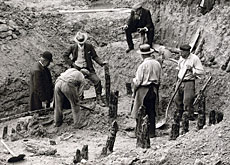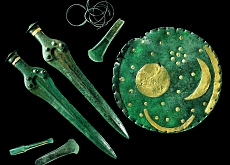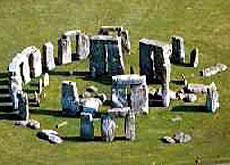Unearthing La Tène’s Celtic mysteries

In 1857 Swiss archaeologist Hans Kopp stumbled on a Celtic treasure trove, including 40 iron swords, at La Tène on the northeastern shores of Lake Neuchâtel.
To celebrate the 150-year anniversary of Kopp’s important discovery, three Swiss museums with the largest La Tène collections have got together to launch the “Year of the Celts”.
Alongside a series of exhibitions and events to mark the occasion, a three-year research project, financed by the National Science Foundation, will be attempting to shed new light on La Tène culture.
“We launched the project on two levels: for the general public to highlight the richness of our own collections, and on a scientific level to enable us to get much closer to the true meaning of La Tène,” Madeline Betschart, director of the Schwab Museum in Biel, told swissinfo.
Over 2,500 relics dating from the late Iron Age (450-50BC) have been uncovered from Lake Neuchâtel’s clear shallow waters.
The name of the site is now permanently associated with this period of history and has become synonymous with the Celtic world.
La Tène culture
Since Kopp pulled the first sword from the lake, La Tène has constantly fascinated archaeologists.
“It’s a very important site of Celtic civilisation,” explained Matthieu Honegger, the new director of the Latenium Museum.
Most historians accept that the inhabitants of the La Tène period were Celts, and that they were one and the same group whom Greek and Roman literary records refer to as “Keltoi” or “Celtae”.
La Tène culture is thought to have developed when Celtic traders – and warriors – came into contact with Greek and Etruscan influences from south of the Alps. The culture grew and spread in eastern France, Switzerland, Austria, southwestern Germany, the Czech Republic, Slovakia and Hungary.
At that time ironworking had reached a very high level of competence and beautiful iron longswords were the hallmark of a warrior society, living in hill forts.
These people were also familiar with the potter’s wheel, horse-drawn chariots, the minting of coins, and highly stylized art forms that combine native, Mediterranean, and even nomadic elements.
Symbolic site
“La Tène doesn’t mean much to the general public, but it’s a highly symbolic site,” explained Gilbert Kaenel, archaeologist in charge of the new research project.
In total, experts unearthed two bridges, several houses and a collection of over 2,500 artefacts, mainly ironwork. Weapons predominate, but there were also brooches, tools, chariot parts, and extremely sophisticated examples of knot-work, metalwork, pottery, glass and geometric drawing. Human and animal bones were also found.
“Edouard Desor [one of the later archaeologists] described it as one of the richest sites he had ever seen, with objects in fantastic condition,” said Kaenel.
One of the most striking features was the unique, elaborate decoration of many of the weapons – the swirling patterns reworking animal, plant and spiral designs commonly recognised as “Celtic”.
Misty lake
Like Lake Neuchâtel on a cold foggy morning, La Tène is still shrouded in certain mystery. One big question mark hangs over the use and symbolism of the site.
Today La Tène is a small holiday resort, but experts believe that 2,500 years ago it might have been a place of ritual offering and sacrifice.
The ancient Celts saw water as the gateway between this world and the next, and it was here that they offered tribute to their gods, using their most precious objects and making human sacrifices, they presume.
In light of discoveries of early Celtic culture made over the past 20-30 years, in particular in France, Kaenel and his team will be attempting to present a clearer picture of La Tène and its ancient inhabitants.
swissinfo, Simon Bradley at La Tène
Year of the Celts
Latenium Museum
May 19: Night of Museums – exhibition and demonstration of Celtic metalwork.
May 20: International Museum Day – exhibition and demonstration of Celtic metalwork.
June 1 – December 31: visit the museum’s hidden collections.
September 8: European Day of Culture: commemoration of the discovery of La Tène site.
September 9: Dendrochronology laboratory visit.
October 6-7: Presentation of films about the Celts.
November 1-3: International round table on La Tène.
Schwab Museum
June 22, 2007 – February 24, 2008: Exhibition “La Tène: research, questions and answers”
June 26: Inauguration of a Celtic bridge in the garden of the Schwab Museum.
The earliest archaeological evidence of the Celts places them in what is now France and western Germany in the late Bronze Age, around 1,200BC.
In the early Iron Age they are linked with Hallstatt culture (800-500BC), named after an archaeological site in Oberösterreich (Upper Austria). They probably began to settle in the British Isles during this period. Between 500-100BC their influence extended from what is now Spain to the shores of the Black Sea. This later Iron Age phase is called La Tène, after the site at Lake Neuchâtel in Switzerland.
The word Celt is derived from Keltoi, the name given by Herodotus and other Greek writers. To the Romans, the continental Celts were known as Galli, or Gauls; those in the British Isles were called Britanni.
Around 400BC the Celts conquered northern Italy, Macedonia, and Thessaly (Thessalia). They plundered Rome in 390, sacked Delphi in 279, and penetrated Asia Minor, where they were known as Galatians.
The “Cisalpine Gauls” of northern Italy were conquered by the Romans in the 2nd century BC; transalpine Gaul (modern France and the Rhineland) was subdued by Julius Caesar in the 1st century BC, and most of Britain came under Roman rule in the 1st century AD. In the same period, the Celts of central Europe were dominated by the Germanic peoples.
In medieval and modern times Celtic traditions and languages survived in Brittany (in western France), Wales, the Scottish Highlands, and Ireland.

In compliance with the JTI standards
More: SWI swissinfo.ch certified by the Journalism Trust Initiative



You can find an overview of ongoing debates with our journalists here. Please join us!
If you want to start a conversation about a topic raised in this article or want to report factual errors, email us at english@swissinfo.ch.